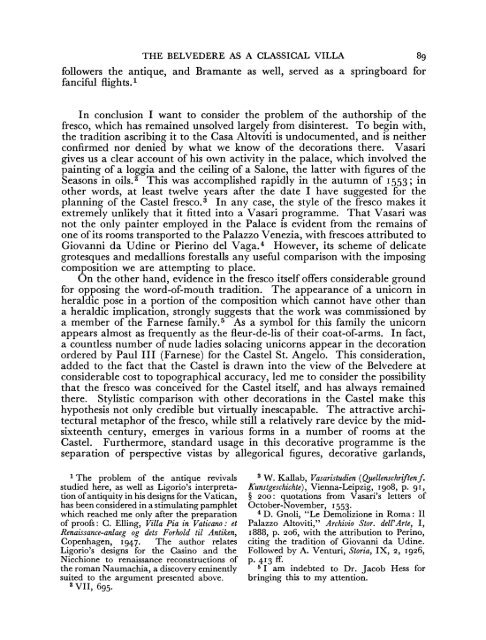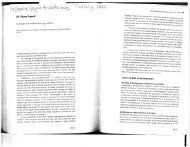The Belvedere as a Classical Villa
The Belvedere as a Classical Villa
The Belvedere as a Classical Villa
You also want an ePaper? Increase the reach of your titles
YUMPU automatically turns print PDFs into web optimized ePapers that Google loves.
THE BELVEDERE AS A CLASSICAL VILLA 89<br />
followers the antique, and Bramante <strong>as</strong> well, served <strong>as</strong> a springboard for<br />
fanciful flights.1<br />
In conclusion I want to consider the problem of the authorship of the<br />
fresco, which h<strong>as</strong> remained unsolved largely from disinterest. To begin with,<br />
the tradition <strong>as</strong>cribing it to the C<strong>as</strong>a Altoviti is undocumented, and is neither<br />
confirmed nor denied by what we know of the decorations there. V<strong>as</strong>ari<br />
gives us a clear account of his own activity in the palace, which involved the<br />
painting of a loggia and the ceiling of a Salone, the latter with figures of the<br />
Se<strong>as</strong>ons in oils.2 This w<strong>as</strong> accomplished rapidly in the autumn of i553; in<br />
other words, at le<strong>as</strong>t twelve years after the date I have suggested for the<br />
planning of the C<strong>as</strong>tel fresco.3 In any c<strong>as</strong>e, the style of the fresco makes it<br />
extremely unlikely that it fitted into a V<strong>as</strong>ari programme. That V<strong>as</strong>ari w<strong>as</strong><br />
not the only painter employed in the Palace is evident from the remains of<br />
one of its rooms transported to the Palazzo Venezia, with frescoes attributed to<br />
Giovanni da Udine or Pierino del Vaga.4 However, its scheme of delicate<br />
grotesques and medallions forestalls any useful comparison with the imposing<br />
composition we are attempting to place.<br />
On the other hand, evidence in the fresco itself offers considerable ground<br />
for opposing the word-of-mouth tradition. <strong>The</strong> appearance of a unicorn in<br />
heraldic pose in a portion of the composition which cannot have other than<br />
a heraldic implication, strongly suggests that the work w<strong>as</strong> commissioned by<br />
a member of the Farnese family.5 As a symbol for this family the unicorn<br />
appears almost <strong>as</strong> frequently <strong>as</strong> the fleur-de-lis of their coat-of-arms. In fact,<br />
a countless number of nude ladies solacing unicorns appear in the decoration<br />
ordered by Paul III (Farnese) for the C<strong>as</strong>tel St. Angelo. This consideration,<br />
added to the fact that the C<strong>as</strong>tel is drawn into the view of the <strong>Belvedere</strong> at<br />
considerable cost to topographical accuracy, led me to consider the possibility<br />
that the fresco w<strong>as</strong> conceived for the C<strong>as</strong>tel itself, and h<strong>as</strong> always remained<br />
there. Stylistic comparison with other decorations in the C<strong>as</strong>tel make this<br />
hypothesis not only credible but virtually inescapable. <strong>The</strong> attractive architectural<br />
metaphor of the fresco, while still a relatively rare device by the midsixteenth<br />
century, emerges in various forms in a number of rooms at the<br />
C<strong>as</strong>tel. Furthermore, standard usage in this decorative programme is the<br />
separation of perspective vist<strong>as</strong> by allegorical figures, decorative garlands,<br />
1 <strong>The</strong> problem of the antique revivals<br />
studied here, <strong>as</strong> well <strong>as</strong> Ligorio's interpreta-<br />
tion of antiquity in his designs for the Vatican,<br />
h<strong>as</strong> been considered in a stimulating pamphlet<br />
which reached me only after the preparation<br />
of proofs: C. Elling, <strong>Villa</strong> Pia in Vaticano: et<br />
Renaissance-anlaeg og dets Forhold til Antiken,<br />
Copenhagen, 1947. <strong>The</strong> author relates<br />
Ligorio's designs for the C<strong>as</strong>ino and the<br />
Nicchione to renaissance reconstructions of<br />
the roman Naumachia, a discovery eminently<br />
suited to the argument presented above.<br />
2 VII, 695.<br />
3 W. Kallab, V<strong>as</strong>aristudien (Quellenschriftenf.<br />
Kunstgeschichte), Vienna-Leipzig, 1908, p. 9',<br />
? 200: quotations from V<strong>as</strong>ari's letters of<br />
October-November, 1553.<br />
4 D. Gnoli, "Le Demolizione in Roma: II<br />
Palazzo Altoviti," Archivio Stor. dell'Arte, I,<br />
1888, p. 206, with the attribution to Perino,<br />
citing the tradition of Giovanni da Udine.<br />
Followed by A. Venturi, Storia, IX, 2, 1926,<br />
p.<br />
5<br />
413<br />
I am<br />
ft.<br />
indebted to Dr. Jacob Hess for<br />
bringing this to my attention.



